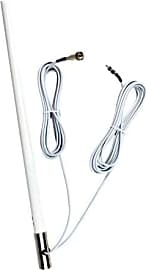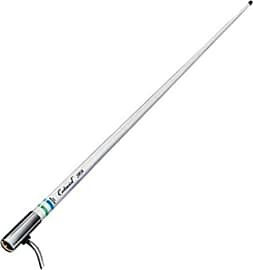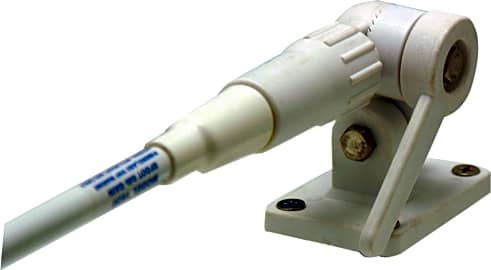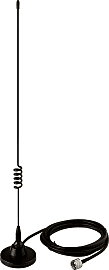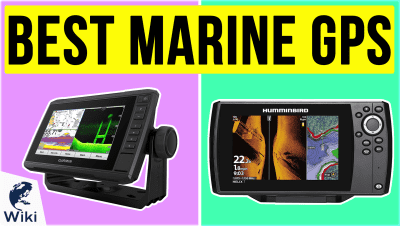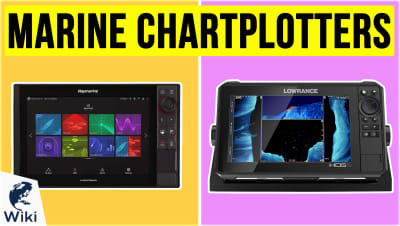The 9 Best VHF Marine Antennas

This wiki has been updated 34 times since it was first published in December of 2016. If you bought a high-quality radio for your boat, you’re also going to need an equally good VHF marine antenna to make the most of it. These units are more than just pieces of wire — they’re delicate machines. Because choosing the best model depends on a range of factors related to both radio and vessel, be sure to read your owner's manual and consider both height and gain before you buy. When users buy our independently chosen editorial recommendations, we may earn commissions to help fund the Wiki.
Editor's Notes
November 17, 2020:
Any marine VHF radio that is not a hand-held unit is useless without an exterior antenna attached. Where you place your antenna has a direct effect on its range and sound quality. Most yachtsmen will fix their aerials at the top of the mast for this reason. Other boaters will find the highest point on their vessel.
The Bingfu Boat Marine VHF was added to the list as an option for mariners who have a malfunction with their existing systems, or those who want a unit that they can simply detach at the end of the day on smaller boats. It has a magnetized base that also lets you use it for your car or caravan. It is powerful for its size and is excellent value compared to other similar choices. We added the Air Wave Marine 150531 as an updated model to the previous one. It is more easily available than its predecessor. The brand is popular with a reputation for quality and longevity.
September 10, 2019:
Before taking to the open seas, it's vital that you have a way to keep in touch with other vessels, as well as stations on land that can provide you with vital information like weather reports in addition to a lifeline in the event of an emergency. To get the best reach possible, you'll want an antenna with some height, which is a pretty basic and important variable in creating a list like this. That's because VHF signals don't have the ability to use the ground or the water to help amplify themselves over greater distances the way UHF signals can, so having an antenna that can reach up and farther out toward the horizon is important.
Availability issues caused us to remove the Tram 16771 from our ranking, but its height at just over three feet was a limiting factor, as well.
Material construction can also be a vital difference among antennae, as these units are going to encounter a large amount of corrosive elements, and need to stand up to wind, sand, salt, and water. It's no surprise, then, that Shakespeare occupies four of our ten slots, as the company is known for making particularly durable housings for their components.
September 26, 2018:
Added Shakespeare Galaxy 5225XT as a high-quality choice for large vessels. Noted the Tram 1610-HC's durability issues vs. price point and lowered the rank. Noticed that Shakespeare gets very positive word-of-mouth.
Special Honors
Scout KS-43 This High performing VHF antenna is foam injected with the Scout 100% waterproof technique, making it perfectly sealed with outstanding resistance to harsh marine environments. With six dB of gain and a copper braided cable, the Scout KS-43 is a notable addition for sailors looking for durability and quality. scoutantenne.com
Come Sail Away
It's hard to imagine crossing the vast, open ocean without the aid of a single instrument.
Shortly after the beginning of the 13th century C.E., an ambitious group of Tahitians set forth on an epic exploratory journey, traveling over 2,600 miles to the as-yet uninhabited Hawaiian islands. Their landing was no accident; several hundred years before any type of remotely modern navigation existed, the wise and well-practiced natives of the future Society Islands set out to reach the rich, virgin archipelago, and that's exactly what they did.
It's hard to imagine crossing the vast, open ocean without the aid of a single instrument. The first sailors did just that, using their knowledge of the stars in the sky, and the currents in the water. This combination of superhuman navigation skill, esoteric ability, and indigenous wizardry was the pride of the ocean-going tribes, and literally the stuff of legends — by the 20th century, it was lost to time, until Nainoa Thompson became the first in hundreds of years to sail a traditional, double-walled canoe from one ancient island community to the other in the manner of the ancients.
Of course, Mr. Thompson is a truly one-in-a-million talent, and a testament to the ingenuity and perseverance of historic Pacific island culture. And while his undeniable skill should be an inspiration to us all, no-one will blame you if you decide to take a GPS and satellite radio along when you sail to Hawaii yourself.
The Not-So-Lost Sailor
Roughly 1,000 years before the invention of the compass, mariners were already quite busy venturing forth across the waves. Ancient Greek sailors left records of epic journeys as far back as year 1000 B.C.E., while Polynesian groups traversed the Ring of Fire a couple thousand years before that. The first maritime navigators used a complex system of indicators that could almost be described as holistic; subtle changes in swells, currents, smells, wildlife behavior, and stars, as well as pure cultural tradition, all contributed to the Southern Pacific natives' peerless navigational methods.
The same holds true as we watch the 20th century sail away into the past; a mere 100 years ago, the concept of radio navigation was in its infancy.
The Age of Exploration was in full swing by the mid-1400s, as Europeans spread the effects of the Renaissance far and wide, at times using little more than a cross-staff and a primitive astrolabe to determine latitude, while longitude and ship speed were, at first, practically restricted to guesswork.
Much like the desert or outer space, the ocean isn't entirely keen on human life. As such, our ability to explore the open ocean has always been closely tied to our engineering capabilities, which is why advancements in navigation and sailing have generally occurred alongside general technological development. The same holds true as we watch the 20th century sail away into the past; a mere 100 years ago, the concept of radio navigation was in its infancy. In today's seas, though, it's a foregone conclusion that nearly every vessel larger than a dinghy has a VHF system (and some high-end dinghies might, as well).
I'm On A Boat
The first and most basic RF navigation consisted of a ship triangulating its position based on those of two known, nearby transmitters. Designed for both aircraft and boats, this simple system was somewhat effective, but the required antennas were prohibitively bulky, and only minimal information was transmitted. This method eventually gave way to reverse RDF, which used known transmitters located at air- and seaports to determine location based on the time delay between the transmitter's remote call and its due North position. Some of these code beacons saw many decades of upgrades and continued use, and the final one was was retired as recently as 1991.
Because modern sailing is more popular and complex than ever, the FCC set aside a relatively small slice of the Very High Frequency band, permitting maritime communication between the 156- and 174-megahertz bands. The system and its specific channels were initially demarcated to ensure that channel 16 remained clear for distress calls.
The first and most basic RF navigation consisted of a ship triangulating its position based on those of two known, nearby transmitters.
Marine VHF systems are traditionally fixed, single-antenna systems that focus on simplex (one-way) transmission. Larger ships with more significant communication needs may employ half- or full-duplex equipment, which allows for reversible one-way, or two-way conversation. Radio navigation generally uses an analog signal, although with the adoption of the latest nautical safety standards, approved setups are also capable of the Digital Select Calling method. This digital-over-VHF adaptation enables even more complex transmissions, and since it minimizes the noise and signal degradation issues that analog comms face, DSC can also somewhat increase range. Unlike standard marine communications, DSC can work with automated and computerized interfaces, rather than the voice operation to which most analog setups are restricted.
While on the open ocean, no matter how free you may feel, it's imperative that you pay close attention to the rules and regulations before you starting blowing up various channels. There's a specific set of words used worldwide (except at smaller local stations), in addition to the official NATO phonetic alphabet and numeric system, that operators must use while communicating over the airwaves. It's vastly important that you follow all procedure regarding terminology, as well as safety channels and response format, to ensure the safety and security of yourself and your passengers.
When choosing an antenna, keep in mind the physical characteristics of the radio waves it works with. It's important to mount all antennas as high on a structure as possible, as an antenna fixed atop a mast can provide as much as 10 times the range of one situated at sea level. By their very nature, quality marine antennas are resistant to weather, wind, ultraviolet rays, and saltwater spray. Some are more durable than others, however, and some are removable, for storing your vessel in small spaces or underneath a cover. Some advanced models include adjustable gain controls, as well as additional communications equipment like GPS or GLONASS location services.
All in all, it's worth taking your time to research which system is right for you. Because the last thing you want is to end up tossed around the high seas without the means to call mayday. With the right antenna setup, that should never be an issue.




